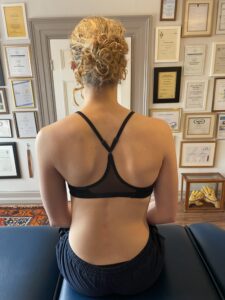Developmental ADOLESCENT IDIOPATHIC SCOLIOSIS (AIS) SUCCESS
This article is a case study of a patient I have helped to significantly improve a scoliosis.
AIS is when the spine curves more than 10 degrees and the curves are multidirectional. When you view a normal spine form behind it appears straight, a small amount of curvature is common and not too much of concern (though it can lead to back pain and worse degeneration in maturing years). A Scoliosis is a curve in one direction side to side and is a common problem I successfully treat for many patients. AIS causes a kyphoscoliosis is a side to side and also a back to front curve causing a hump to form in the back. This affects girls more than boys and most often occurs in childhood and early teens as the child grows quickly.
There are multiple reasons including cerebral palsy and muscular dystrophy, but also very commonly with a deformity brought on by rapid unequal growth in the spine – This is what had affected my patient.
Common symptoms in AIS
- difference in shoulder heights – often associated with a lot of field hockey
- Altered hip height position
- Shoulder blade in odd position and winging out
- Bending forward – each side of the spine appear different in heights
- Head isn’t centred on the body
- Arms hang different on each side
Most cases we see at The Twyford clinic are Adolescent Idiopathic Scoliosis – aged 10 to 18 and this is what my patient had with a kyphosis present
CASE STUDY
A 15 year old girl attended with a history of pain starting 7 months prior to my first assessment. She was getting worsening mid thoracic ( back) pain when playing sport, sitting for studying and was starting to get pain constantly. She had been growing quickly the previous few months.
On her examination she presented with a scoliosis the spine bent to the left and forward on the right side with her ribs also affected protruding back where they join on to the spine. Performing Adams’ test (leaning forward) showed the amount of deformation – see picture above
The front of her chest was also concave (sunk in) due to the deformity forming.
The picture above shows the degree of curvature my patient presented with initially.
If this was left alone the deformity could become permanent and disabling due to pain and aesthetically an issue. Over the next 2 years I treated the patient with specific mobilisations of her spine and an ongoing programme of home stretches including use of a foam roller.
The successful result of treatment has straightened my patients spine significantly with only a minor difference on the spine, she is now 17 and very happy with the result. See picture below:
![]() Successful straightening after treatment.
Successful straightening after treatment.
If your child has an idiopathic scoliosis – We can help.
We also treat adult deformations of scoliosis and spine pain which can be caused by many factors. Scoliosis normally present in adults is due to degenerative changes from osteoarthritis, ankylosing spondylitis, poor posture, and muscular imbalances.
Contact us for an appointment and we can help straighten you out.
Call 01962 714 979


